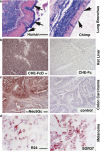Diversity in cell surface sialic acid presentations: implications for biology and disease
- PMID: 17632542
- PMCID: PMC7100186
- DOI: 10.1038/labinvest.3700656
Diversity in cell surface sialic acid presentations: implications for biology and disease
Abstract
Sialic acids (Sias) are typically found as terminal monosaccharides attached to cell surface glycoconjugates. They play many important roles in many physiological and pathological processes, including microbe binding that leads to infections, regulation of the immune response, the progression and spread of human malignancies and in certain aspects of human evolution. This review will provide some examples of these diverse roles of Sias and briefly address immunohistochemical approaches to their detection.
Figures


References
-
- Varki A, Cummings R, Esko JD. Essentials of Glycobiology. Cold Spring Harbor Laboratory Press: Plainview, NY; 1999. - PubMed
-
- Drickamer K, Taylor M. Introduction to Glycobiology. Oxford University Press: Oxford, UK; 2006.
Publication types
MeSH terms
Substances
LinkOut - more resources
Full Text Sources
Other Literature Sources

